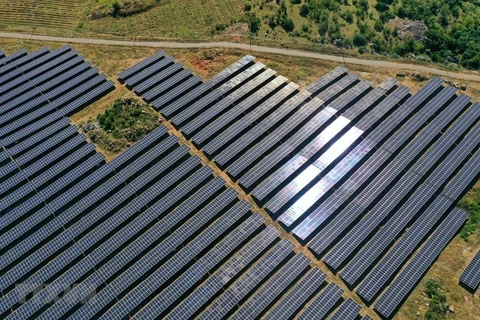Hanoi (VNA) - Vietnam is striving for a commercial electricity output of 337.5 billion kWh by 2025 and 478.1 billion kWh by 2030, down 15 billion kWh and nearly 230 billion kWh compared with those in the adjusted Power Planning VII.
The revision was contained in a report from the Ministry of Industry and Trade (MoIT) delivered to the National Assembly Economic Committee’s session on September 7 reviewing the electricity sector and electricity development measures by 2030 to better meet socio-economic development requirements.
The report highlighted that Vietnam’s power output enjoyed a ten-fold increase from 1990 to 2019. As of late 2019, total produced and imported electricity output was 239 billion kWh.
Special attention was paid to building and upgrading power supply infrastructure. All communes and 99.52 percent of households now have access to electricity.
The Government also issued a range of mechanisms and policies adjusting power prices in accordance with the market mechanism, thus facilitating the sector’s financial autonomy.
The report also pointed to 10 major power projects that ought to have been put into operation during 2016-2020 but are proceeding slowly, including Song Hau 1, Thai Binh 2, Long Phu 1, Na Duong 2, and Cam Pha 3.
The MoIT has emphasised that slow progress poses a high risk to power supplies during the 2021-2025 period.
To ensure that supply and demand are balanced, the sector has been advised to seek measures to optimise existing power sources and develop electricity from renewable energies from the beginning of 2021.
Minister of Industry and Trade Tran Tuan Anh said the electricity sector will prioritise developing power sources from renewable energies such as wind and solar power as well as liquefied natural gas (LNG) power, and will continue to increase power imports from Laos, which are to total 3,000 MW by 2025./.
The revision was contained in a report from the Ministry of Industry and Trade (MoIT) delivered to the National Assembly Economic Committee’s session on September 7 reviewing the electricity sector and electricity development measures by 2030 to better meet socio-economic development requirements.
The report highlighted that Vietnam’s power output enjoyed a ten-fold increase from 1990 to 2019. As of late 2019, total produced and imported electricity output was 239 billion kWh.
Special attention was paid to building and upgrading power supply infrastructure. All communes and 99.52 percent of households now have access to electricity.
The Government also issued a range of mechanisms and policies adjusting power prices in accordance with the market mechanism, thus facilitating the sector’s financial autonomy.
The report also pointed to 10 major power projects that ought to have been put into operation during 2016-2020 but are proceeding slowly, including Song Hau 1, Thai Binh 2, Long Phu 1, Na Duong 2, and Cam Pha 3.
The MoIT has emphasised that slow progress poses a high risk to power supplies during the 2021-2025 period.
To ensure that supply and demand are balanced, the sector has been advised to seek measures to optimise existing power sources and develop electricity from renewable energies from the beginning of 2021.
Minister of Industry and Trade Tran Tuan Anh said the electricity sector will prioritise developing power sources from renewable energies such as wind and solar power as well as liquefied natural gas (LNG) power, and will continue to increase power imports from Laos, which are to total 3,000 MW by 2025./.
VNA
























